The Importance of Cumulus Parameterization and Resolution in Simulating Rainfall over Peninsular Malaysia
Abstract
1. Introduction
2. Materials and Methods
2.1. Experimental Design
2.2. Model Validation Method
3. Results & Discussion
3.1. Cumulus Evaluation
3.2. Differential of Model Resolution Simulations
3.2.1. The Differences in 25 km and 5 km Simulations
3.2.2. Added Value of Using Higher Resolution Simulations
4. Conclusions
Author Contributions
Funding
Institutional Review Board Statement
Informed Consent Statement
Acknowledgments
Conflicts of Interest
References
- Phillips, N.A. The general circulation of the atmosphere: A numerical experiment. Q. J. R. Meteorol. Soc. 1956, 82, 123–164. [Google Scholar] [CrossRef]
- Giorgi, F.; Bates, G.T. The climatological skill of a regional model over complex terrain. Mon. Weather. Rev. 1989, 117, 2325–2347. [Google Scholar] [CrossRef]
- Giorgi, F. Simulation of regional climate using a limited area model nested in a general circulation model. J. Clim. 1990, 3, 941–963. [Google Scholar] [CrossRef]
- Arakawa, A. Modelling clouds and cloud processes for use in climate models. In The Physical Basis of Climate and Climate Modelling; SEE N 76-19675 10-47; WMO: Geneva, Switzerland, 1975; pp. 187–197. [Google Scholar]
- Peña-Arancibia, J.L.; Van Dijk, A.I.; Renzullo, L.J.; Mulligan, M. Evaluation of precipitation estimation accuracy in reanalyses, satellite products, and an ensemble method for regions in Australia and South and East Asia. J. Hydrometeorol. 2013, 14, 1323–1333. [Google Scholar] [CrossRef]
- Ratna, S.B.; Ratnam, J.; Behera, S.; Tangang, F.T.; Yamagata, T. Validation of the WRF regional climate model over the subregions of Southeast Asia: Climatology and interannual variability. Clim. Res. 2017, 71, 263–280. [Google Scholar] [CrossRef][Green Version]
- Juneng, L.; Tangang, F.; Chung, J.X.; Ngai, S.T.; Tay, T.W.; Narisma, G.; Cruz, F.; Phan-Van, T.; Ngo-Duc, T.; Santisirisomboon, J. Sensitivity of Southeast Asia rainfall simulations to cumulus and air-sea flux parameterizations in RegCM4. Clim. Res. 2016, 69, 59–77. [Google Scholar] [CrossRef]
- Salimun, E.; Tangang, F.; Juneng, L. Simulation of heavy precipitation episode over eastern Peninsular Malaysia using MM5: Sensitivity to cumulus parameterization schemes. Meteorol. Atmos. Phys. 2010, 107, 33–49. [Google Scholar] [CrossRef]
- Zhang, W.; Wang, Y.; Jin, F.F.; Stuecker, M.F.; Turner, A.G. Impact of different El Niño types on the El Niño/IOD relationship. Geophys. Res. Lett. 2015, 42, 8570–8576. [Google Scholar] [CrossRef]
- Wyngaard, J.C. Toward numerical modeling in the “Terra Incognita”. J. Atmos. Sci. 2004, 61, 1816–1826. [Google Scholar] [CrossRef]
- Gerard, L. An integrated package for subgrid convection, clouds and precipitation compatible with meso-gamma scales. Q. J. R. Meteorol. Soc. A J. Atmos. Sci. Appl. Meteorol. Phys. Oceanogr. 2007, 133, 711–730. [Google Scholar] [CrossRef]
- Kealy, J.C.; Efstathiou, G.A.; Beare, R.J. The onset of resolved boundary-layer turbulence at grey-zone resolutions. Bound. Layer Meteorol. 2019, 171, 31–52. [Google Scholar] [CrossRef]
- Schwartz, C.S.; Kain, J.S.; Weiss, S.J.; Xue, M.; Bright, D.R.; Kong, F.; Thomas, K.W.; Levit, J.J.; Coniglio, M.C. Next-day convection-allowing WRF model guidance: A second look at 2-km versus 4-km grid spacing. Mon. Weather. Rev. 2009, 137, 3351–3372. [Google Scholar] [CrossRef]
- Kain, J.S.; Weiss, S.J.; Bright, D.R.; Baldwin, M.E.; Levit, J.J.; Carbin, G.W.; Schwartz, C.S.; Weisman, M.L.; Droegemeier, K.K.; Weber, D.B. Some practical considerations regarding horizontal resolution in the first generation of operational convection-allowing NWP. Weather. Forecast. 2008, 23, 931–952. [Google Scholar] [CrossRef]
- Field, P.R.; Brožková, R.; Chen, M.; Dudhia, J.; Lac, C.; Hara, T.; Honnert, R.; Olson, J.; Siebesma, P.; de Roode, S. Exploring the convective grey zone with regional simulations of a cold air outbreak. Q. J. R. Meteorol. Soc. 2017, 143, 2537–2555. [Google Scholar] [CrossRef]
- Petch, J.; Brown, A.; Gray, M. The impact of horizontal resolution on the simulations of convective development over land. Q. J. R. Meteorol. Soc. A J. Atmos. Sci. Appl. Meteorol. Phys. Oceanogr. 2002, 128, 2031–2044. [Google Scholar] [CrossRef]
- Bryan, G.H.; Wyngaard, J.C.; Fritsch, J.M. Resolution requirements for the simulation of deep moist convection. Mon. Weather. Rev. 2003, 131, 2394–2416. [Google Scholar] [CrossRef]
- Holloway, C.E. Convective aggregation in realistic convective-scale simulations. J. Adv. Modeling Earth Syst. 2017, 9, 1450–1472. [Google Scholar] [CrossRef]
- Sakradzija, M.; Seifert, A.; Dipankar, A. A stochastic scale-aware parameterization of shallow cumulus convection across the convective gray zone. J. Adv. Modeling Earth Syst. 2016, 8, 786–812. [Google Scholar] [CrossRef]
- Arakawa, A.; Chen, J.-M. Closure assumptions in the cumulus parameterization problem. J. Meteorol. Soc. Jpn. Ser. II 1986, 64, 107–131. [Google Scholar] [CrossRef]
- Hammarstrand, U. Questions involving the use of traditional convection parameterization in NWP models with a higher resolution. Tellus A Dyn. Meteorol. Oceanogr. 1998, 50, 265–282. [Google Scholar] [CrossRef]
- Deng, A.; Stauffer, D.R. On improving 4-km mesoscale model simulations. J. Appl. Meteorol. Climatol. 2006, 45, 361–381. [Google Scholar] [CrossRef]
- Kotroni, V.; Lagouvardos, K. Evaluation of MM5 high-resolution real-time forecasts over the urban area of Athens, Greece. J. Appl. Meteorol. 2004, 43, 1666–1678. [Google Scholar] [CrossRef]
- Skamarock, W.; Klemp, J.; Dudhia, J.; Gill, D.; Barker, D.G.; Duda, M.; Huang, X.-Y.; Wang, W.; Powers, J.G. A Description of the Advanced Research WRF Version 3; NCAR Technical Note; National Center for Atmospheric Research (NCAR)/TN-475+ STR, NCAR: Boulder, CO, USA, 2008. [Google Scholar]
- Kain, J.S. The Kain–Fritsch convective parameterization: An update. J. Appl. Meteorol. 2004, 43, 170–181. [Google Scholar] [CrossRef]
- Janjić, Z.I. The step-mountain eta coordinate model: Further developments of the convection, viscous sublayer, and turbulence closure schemes. Mon. Weather. Rev. 1994, 122, 927–945. [Google Scholar] [CrossRef]
- Grell, G.A. A Description of the Fifth-Generation Penn State/NCAR Mesoscale Model (MM5); Technical NoteNCAR/TN-398+ STR; National Center for Atmospheric Research (NCAR): Boulder, SO, USA, 1995. [Google Scholar]
- Jeworrek, J.; West, G.; Stull, R. Evaluation of cumulus and microphysics parameterizations in WRF across the convective gray zone. Weather. Forecast. 2019, 34, 1097–1115. [Google Scholar] [CrossRef]
- Juneng, L.; Tangang, F.T. Evolution of ENSO-related rainfall anomalies in Southeast Asia region and its relationship with atmosphere–ocean variations in Indo-Pacific sector. Clim. Dyn. 2005, 25, 337–350. [Google Scholar] [CrossRef]
- Amirudin, A.A.; Salimun, E.; Tangang, F.; Juneng, L.; Zuhairi, M. Differential influences of teleconnections from the Indian and Pacific Oceans on rainfall variability in Southeast Asia. Atmosphere 2020, 11, 886. [Google Scholar] [CrossRef]
- Lim, S.Y.; Marzin, C.; Xavier, P.; Chang, C.-P.; Timbal, B. Impacts of boreal winter monsoon cold surges and the interaction with MJO on Southeast Asia rainfall. J. Clim. 2017, 30, 4267–4281. [Google Scholar] [CrossRef]
- Ayoub, A.B.; Tangang, F.; Juneng, L.; Tan, M.L.; Chung, J.X. Evaluation of gridded precipitation datasets in Malaysia. Remote Sens. 2020, 12, 613. [Google Scholar] [CrossRef]
- Wagner, A.; Heinzeller, D.; Wagner, S.; Rummler, T.; Kunstmann, H. Explicit convection and scale-aware cumulus parameterizations: High-resolution simulations over areas of different topography in Germany. Mon. Weather. Rev. 2018, 146, 1925–1944. [Google Scholar] [CrossRef]
- Li, X.; Xie, S.-P.; Gille, S.T.; Yoo, C. Atlantic-induced pan-tropical climate change over the past three decades. Nat. Clim. Chang. 2016, 6, 275–279. [Google Scholar] [CrossRef]
- Ngo-Duc, T.; Tangang, F.T.; Santisirisomboon, J.; Cruz, F.; Trinh-Tuan, L.; Nguyen-Xuan, T.; Phan-Van, T.; Juneng, L.; Narisma, G.; Singhruck, P. Performance evaluation of RegCM4 in simulating extreme rainfall and temperature indices over the CORDEX-Southeast Asia region. Int. J. Climatol. 2017, 37, 1634–1647. [Google Scholar] [CrossRef]
- Ratna, S.B.; Ratnam, J.; Behera, S.; Rautenbach, C.d.; Ndarana, T.; Takahashi, K.; Yamagata, T. Performance assessment of three convective parameterization schemes in WRF for downscaling summer rainfall over South Africa. Clim. Dyn. 2014, 42, 2931–2953. [Google Scholar] [CrossRef]
- Huang, D.; Gao, S. Impact of different cumulus convective parameterization schemes on the simulation of precipitation over China. Tellus A Dyn. Meteorol. Oceanogr. 2017, 69, 1406264. [Google Scholar] [CrossRef]
- Otieno, G.; Mutemi, J.; Opijah, F.; Ogallo, L.; Omondi, M. The sensitivity of rainfall characteristics to cumulus parameterization schemes from a WRF model. Part I: A case study over East Africa during wet years. Pure Appl. Geophys. 2020, 177, 1095–1110. [Google Scholar] [CrossRef]
- Raktham, C.; Bruyère, C.; Kreasuwun, J.; Done, J.; Thongbai, C.; Promnopas, W. Simulation sensitivities of the major weather regimes of the Southeast Asia region. Clim. Dyn. 2015, 44, 1403–1417. [Google Scholar] [CrossRef]
- Huo, Y.; Peltier, W.R. The southeast asian monsoon: Dynamically downscaled climate change projections and high resolution regional ocean modelling on the effects of the Tibetan Plateau. Clim. Dyn. 2021, 56, 2597–2616. [Google Scholar] [CrossRef]
- Kong, S.S.-K.; Sentian, J.; Bidin, K. Evaluation of Weather Research Forecast (WRF) modeling system on surface temperature and precipitation over Malaysia region. Adv. Nat. Appl. Sci. 2015, 9, 20–25. [Google Scholar]
- Ratna, S.B.; Osborn, T.; Joshi, M.M. Multidecadal climate variability of East Asia during the last millennium: Roles of external forcing and internal variability. In Proceedings of the AGU Fall Meeting Abstracts, Washington, DC, USA, 10–14 December 2018; p. PP43C-1942. [Google Scholar]
- Cruz, F.T.; Sasaki, H.; Narisma, G.T. Assessing the sensitivity of the non-hydrostatic regional climate model to boundary conditions and convective schemes over the Philippines. J. Meteorol. Soc. Jpn. Ser. II 2016, 94, 165–179. [Google Scholar] [CrossRef]
- Shepherd, T.J.; Walsh, K.J. Sensitivity of hurricane track to cumulus parameterization schemes in the WRF model for three intense tropical cyclones: Impact of convective asymmetry. Meteorol. Atmos. Phys. 2017, 129, 345–374. [Google Scholar] [CrossRef]
- Gilliland, E.K.; Rowe, C.M. A comparison of cumulus parameterization schemes in the WRF model. In Proceedings of the 87th AMS Annual Meeting & 21th Conference on Hydrology, San Antonio, TX, USA, 13–18 January 2007. [Google Scholar]
- Pan, H.-l.; Wu, W.-S. Implementing a mass flux convection parameterization package for the NMC medium-range forecast model. NMC Off. Note 1995, 409. [Google Scholar]
- Raghavan, S.V.; Liu, J.; Nguyen, N.S.; Vu, M.T.; Liong, S.-Y. Assessment of CMIP5 historical simulations of rainfall over Southeast Asia. Theor. Appl. Climatol. 2018, 132, 989–1002. [Google Scholar] [CrossRef]
- Roux, G.; Liu, Y.; Monache, L.; Sheu, R.-S.; Warner, T.T. Verification of high resolution WRF-RTFDDA surface forecasts over mountains and plains. In Proceedings of the 10th WRF Users’ Workshop, Boulder, CO, USA, 23–26 June 2009; pp. 20–23. [Google Scholar]
- Wang, G.; Cai, W. Two-year consecutive concurrences of positive Indian Ocean Dipole and Central Pacific El Niño preconditioned the 2019/2020 Australian “black summer” bushfires. Geosci. Lett. 2020, 7, 19. [Google Scholar] [CrossRef]
- Suhaila, J.; Deni, S.M.; Zin, W.W.; Jemain, A.A. Trends in peninsular Malaysia rainfall data during the southwest monsoon and northeast monsoon seasons: 1975–2004. Sains Malays. 2010, 39, 533–542. [Google Scholar]
- Loo, Y.Y.; Billa, L.; Singh, A. Effect of climate change on seasonal monsoon in Asia and its impact on the variability of monsoon rainfall in Southeast Asia. Geosci. Front. 2015, 6, 817–823. [Google Scholar] [CrossRef]
- Jamaluddin, A.F.; Tangang, F.; Chung, J.X.; Juneng, L.; Sasaki, H.; Takayabu, I. Investigating the mechanisms of diurnal rainfall variability over Peninsular Malaysia using the non-hydrostatic regional climate model. Meteorol. Atmos. Phys. 2018, 130, 611–633. [Google Scholar] [CrossRef]
- Yáñez-Morroni, G.; Gironás, J.; Caneo, M.; Delgado, R.; Garreaud, R. Using the weather research and forecasting (WRF) model for precipitation forecasting in an Andean region with complex topography. Atmosphere 2018, 9, 304. [Google Scholar] [CrossRef]
- Schumacher, V.; Fernández, A.; Justino, F.; Comin, A. WRF high resolution dynamical downscaling of precipitation for the Central Andes of Chile and Argentina. Front. Earth Sci. 2020, 8, 1–19. [Google Scholar] [CrossRef]
- Demory, M.-E.; Vidale, P.L.; Roberts, M.J.; Berrisford, P.; Strachan, J.; Schiemann, R.; Mizielinski, M.S. The role of horizontal resolution in simulating drivers of the global hydrological cycle. Clim. Dyn. 2014, 42, 2201–2225. [Google Scholar] [CrossRef]
- Mesinger, F.; Arakawa, A. Numerical Methods Used in Atmospheric Models; Global Atmospheric Research Programme (GARP), WMO-ICSU Joint Scientific Committee: Geneva, Switzerland, 1976; Volume 1. [Google Scholar]
- Bhatt, B.C.; Sobolowski, S.; Higuchi, A. Simulation of diurnal rainfall variability over the Maritime Continent with a high-resolution regional climate model. J. Meteorol. Soc. Jpn. Ser. II 2016, 94, 89–103. [Google Scholar] [CrossRef][Green Version]
- Oki, T.; Musiake, K. Seasonal change of the diurnal cycle of precipitation over Japan and Malaysia. J. Appl. Meteorol. Climatol. 1994, 33, 1445–1463. [Google Scholar] [CrossRef]
- Goines, D.; Kennedy, A. Precipitation From a Multiyear Database of Convection-Allowing WRF Simulations. J. Geophys. Res. Atmos. 2018, 123, 2424–2453. [Google Scholar] [CrossRef]
- Lim, J.T. Characteristics of the Winter Monsoon over the Malaysian Region; University of Hawai’i at Manoa: Ann Arbor, MI, USA, 1979. [Google Scholar]
- Auriol, F.; Gayet, J.-F.; Febvre, G.; Jourdan, O.; Labonnote, L.; Brogniez, G. In situ observation of cirrus scattering phase functions with 22 and 46 halos: Cloud field study on 19 February 1998. J. Atmos. Sci. 2001, 58, 3376–3390. [Google Scholar] [CrossRef]
- Lorenz, E.N. The predictability of a flow which possesses many scales of motion. Tellus 1969, 21, 289–307. [Google Scholar] [CrossRef]
- Clark, A.J.; Gallus, W.A., Jr.; Xue, M.; Kong, F. A comparison of precipitation forecast skill between small convection-allowing and large convection-parameterizing ensembles. Weather. Forecast. 2009, 24, 1121–1140. [Google Scholar] [CrossRef]

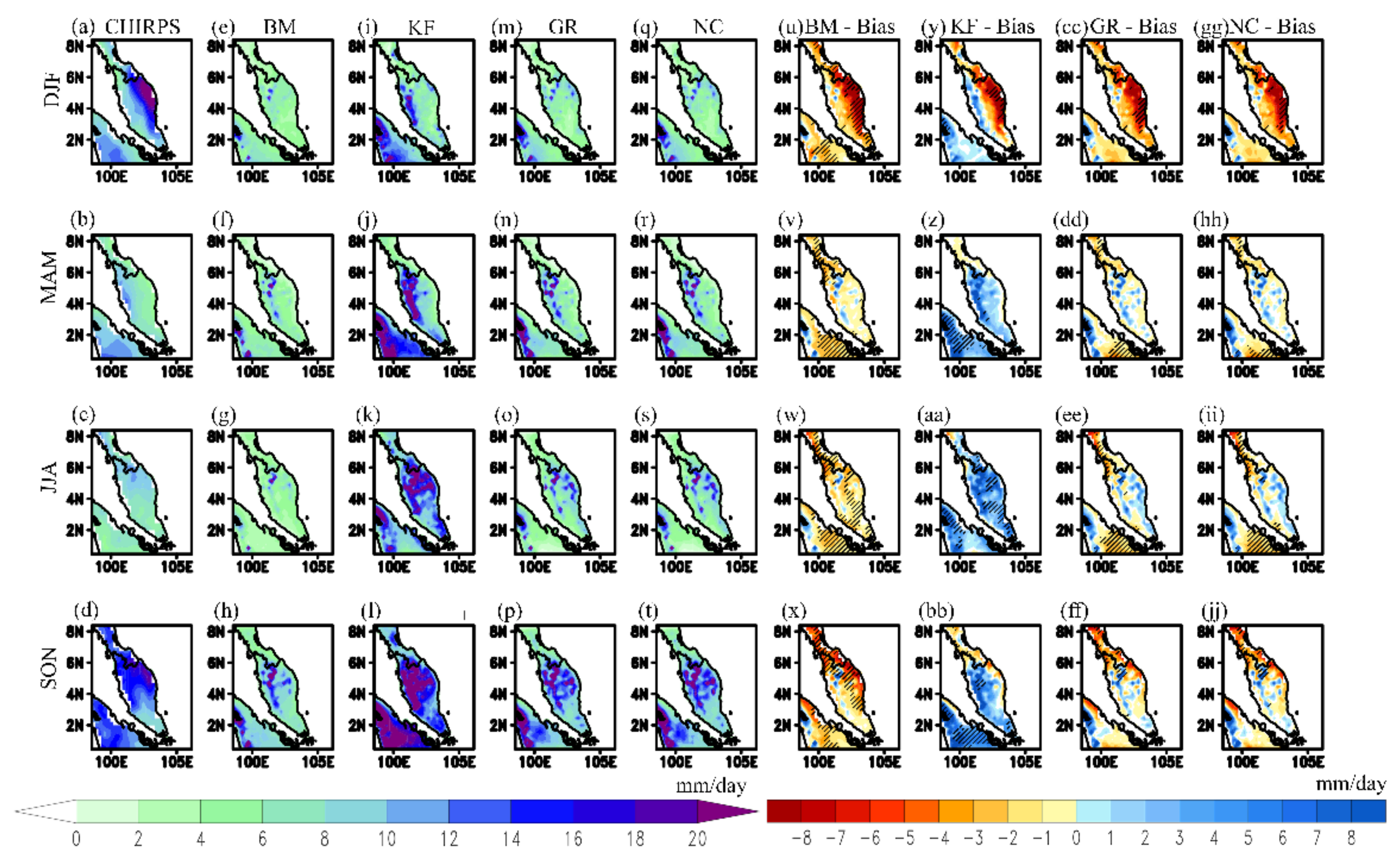

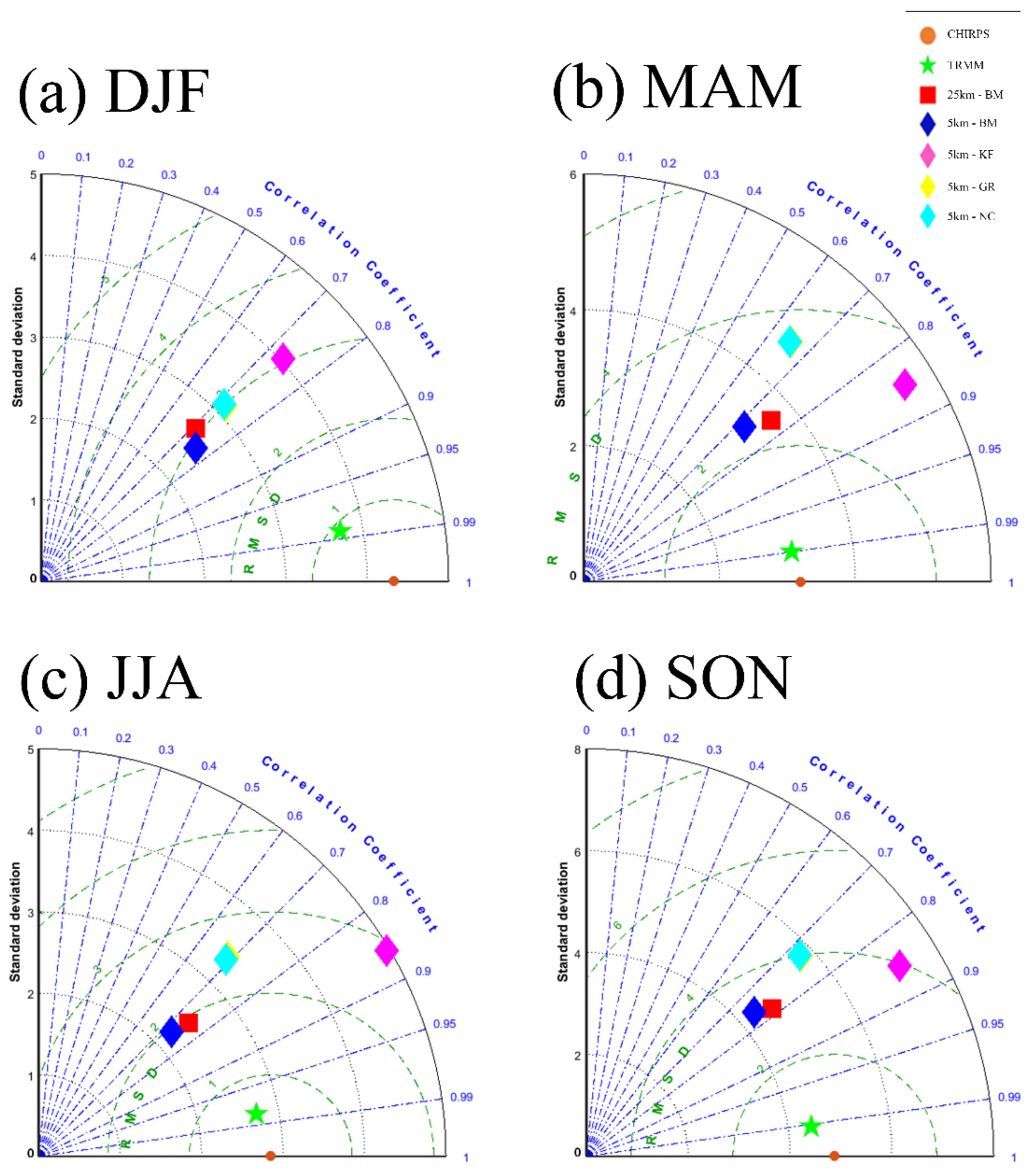
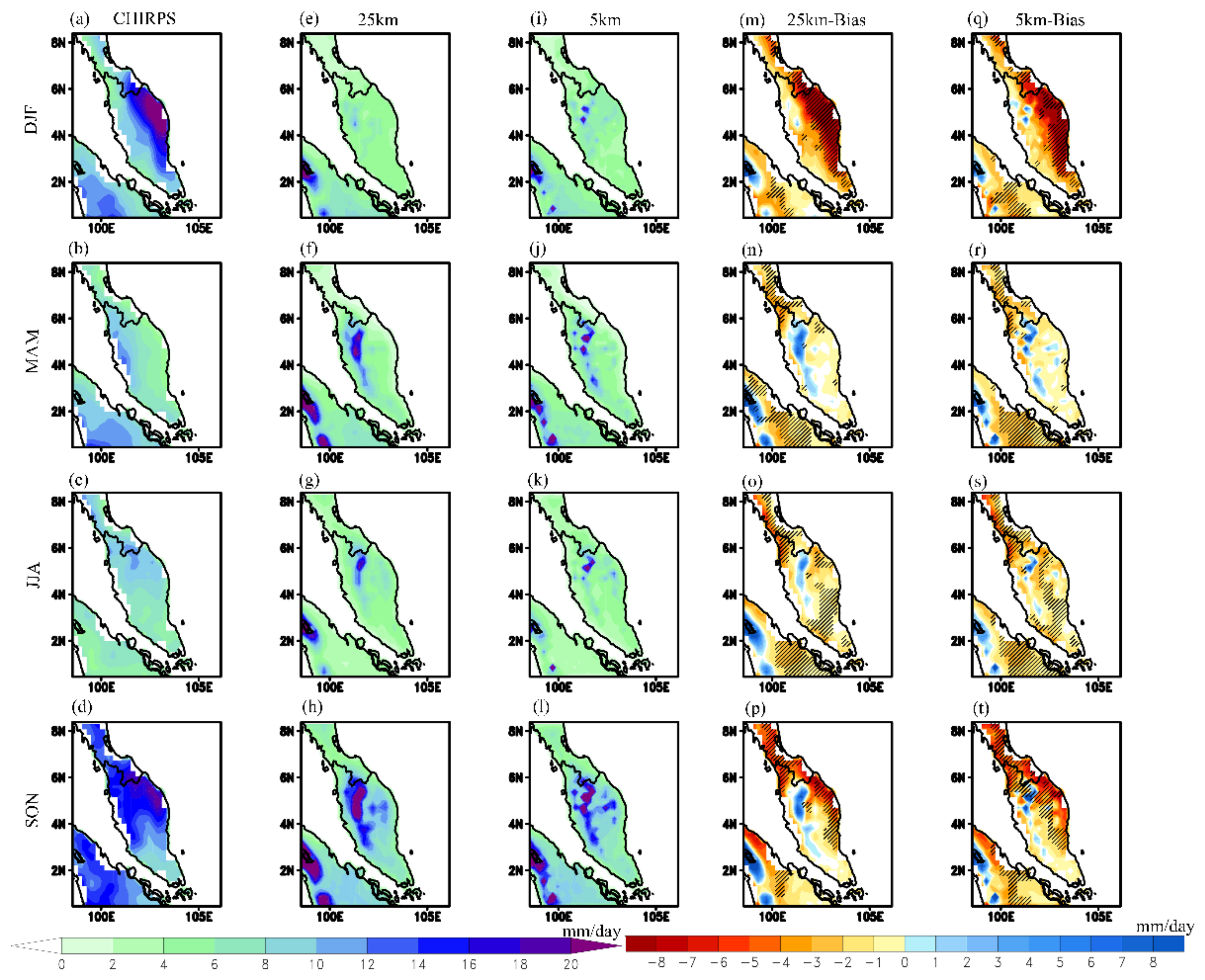
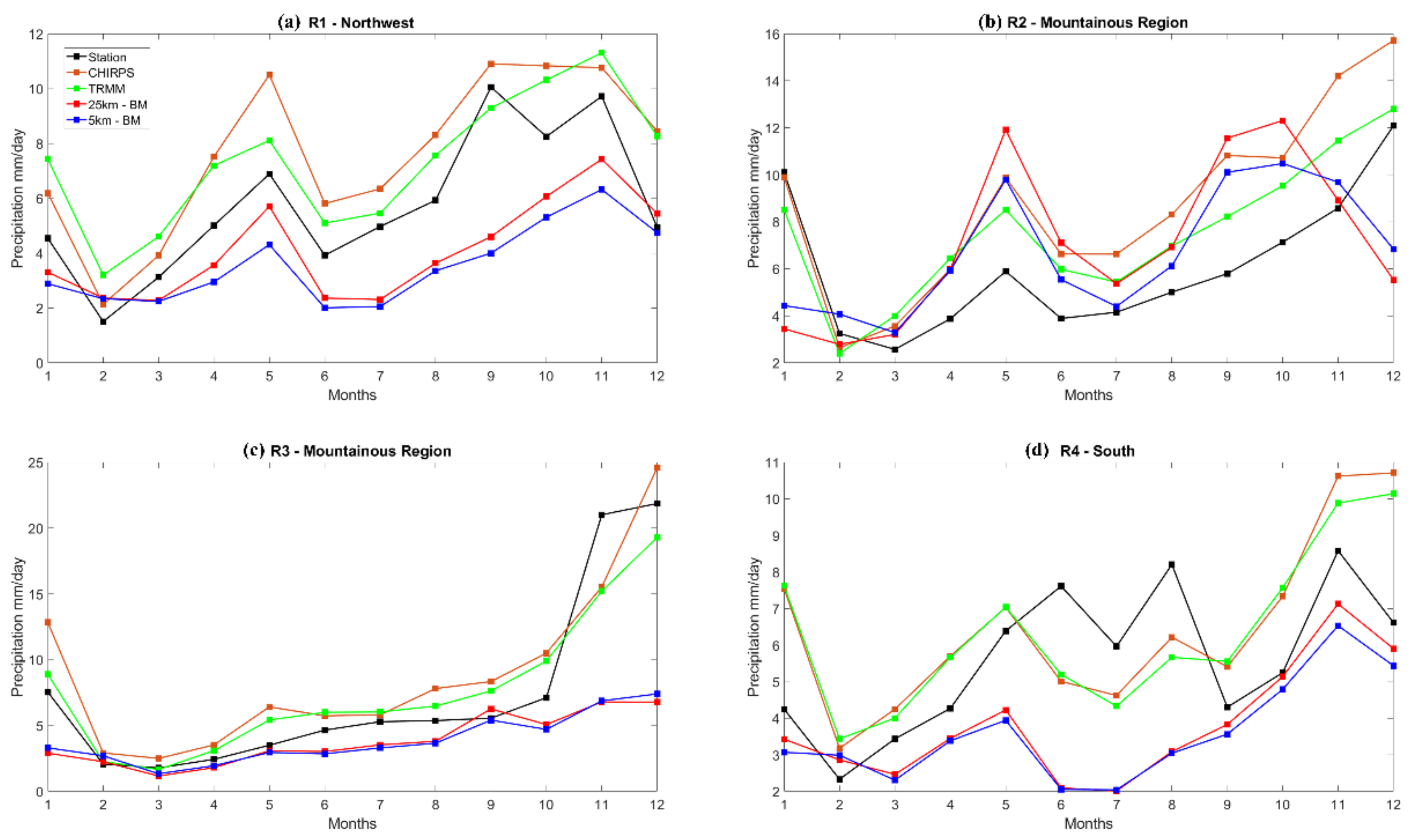
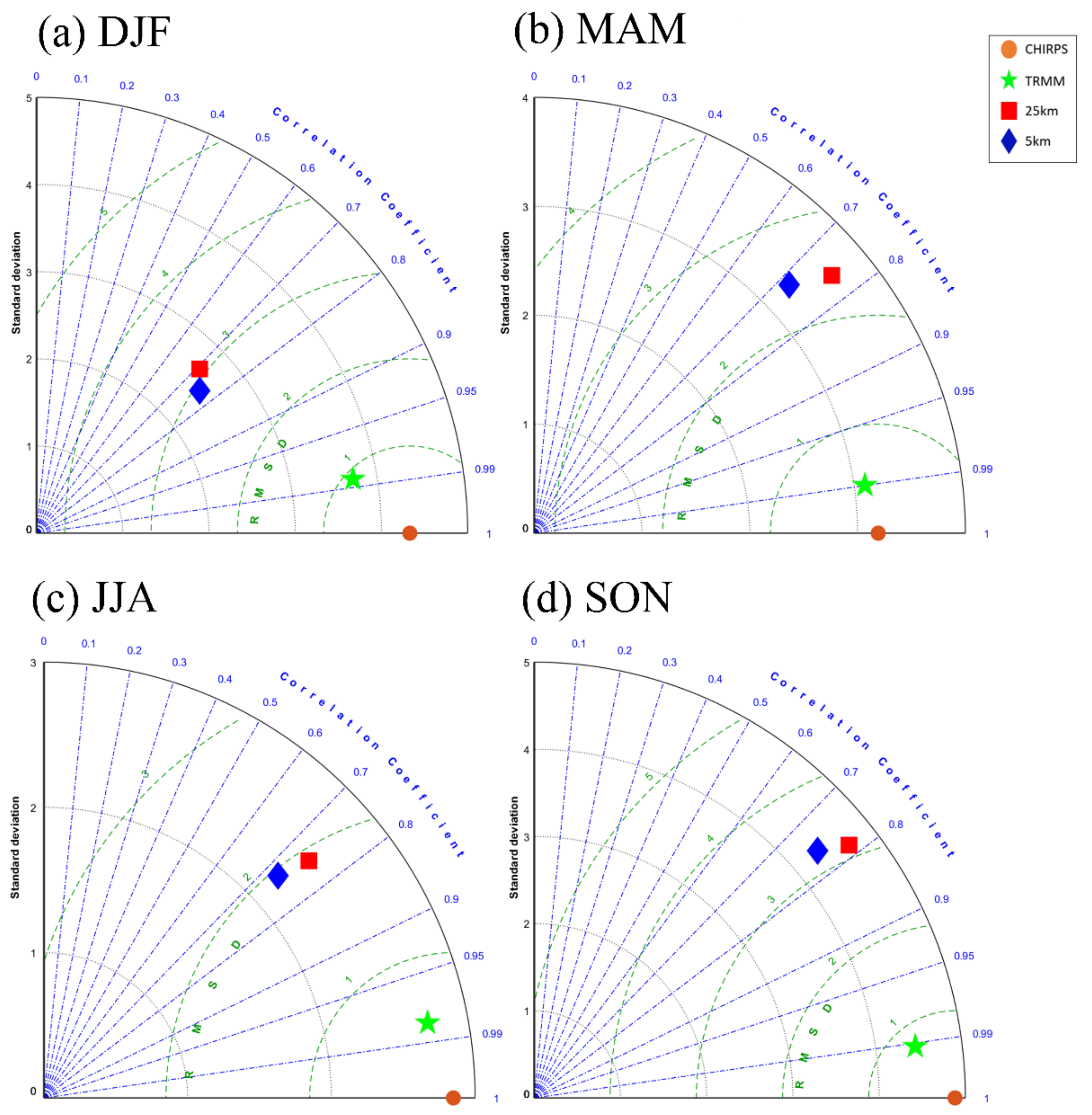
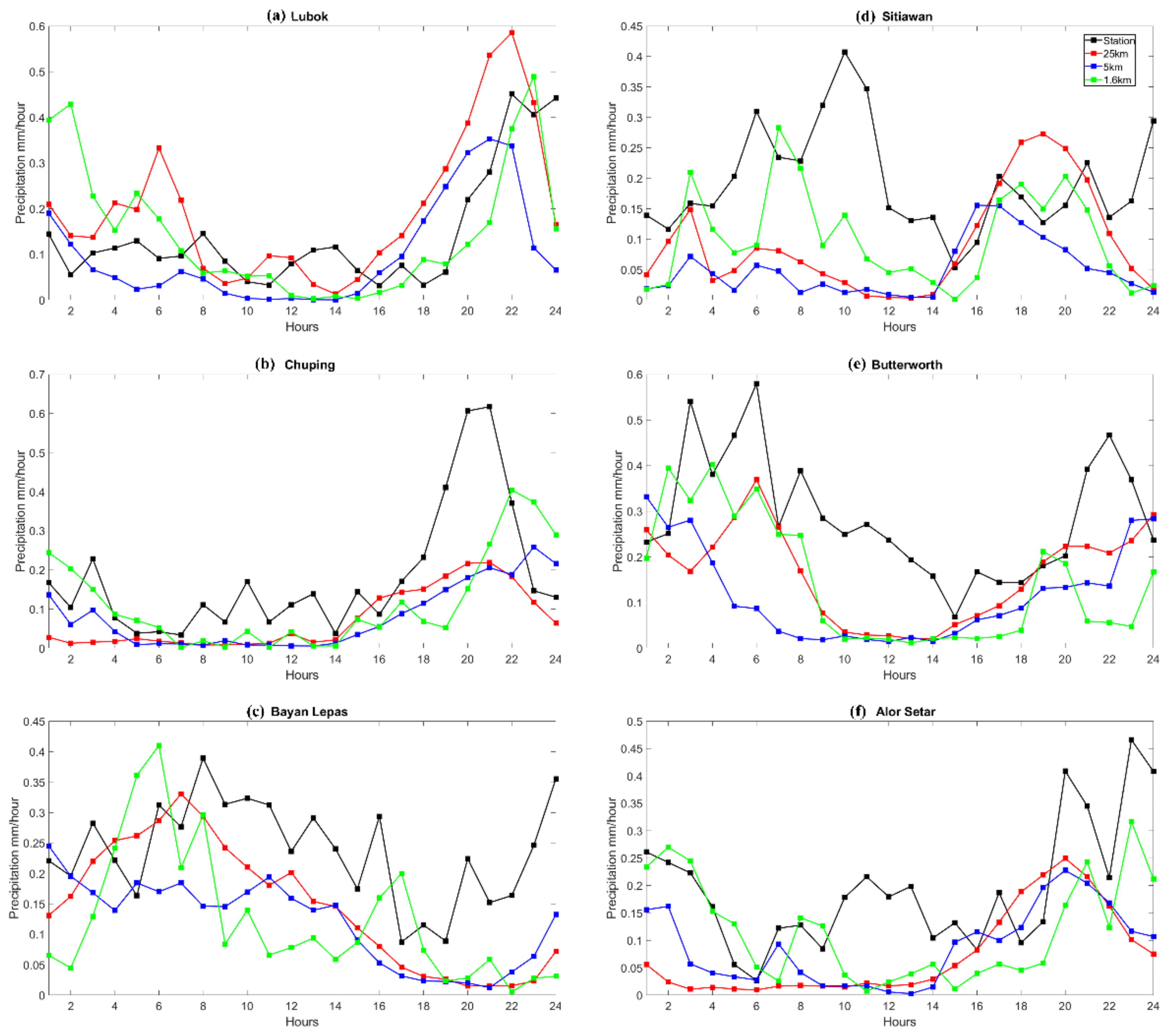


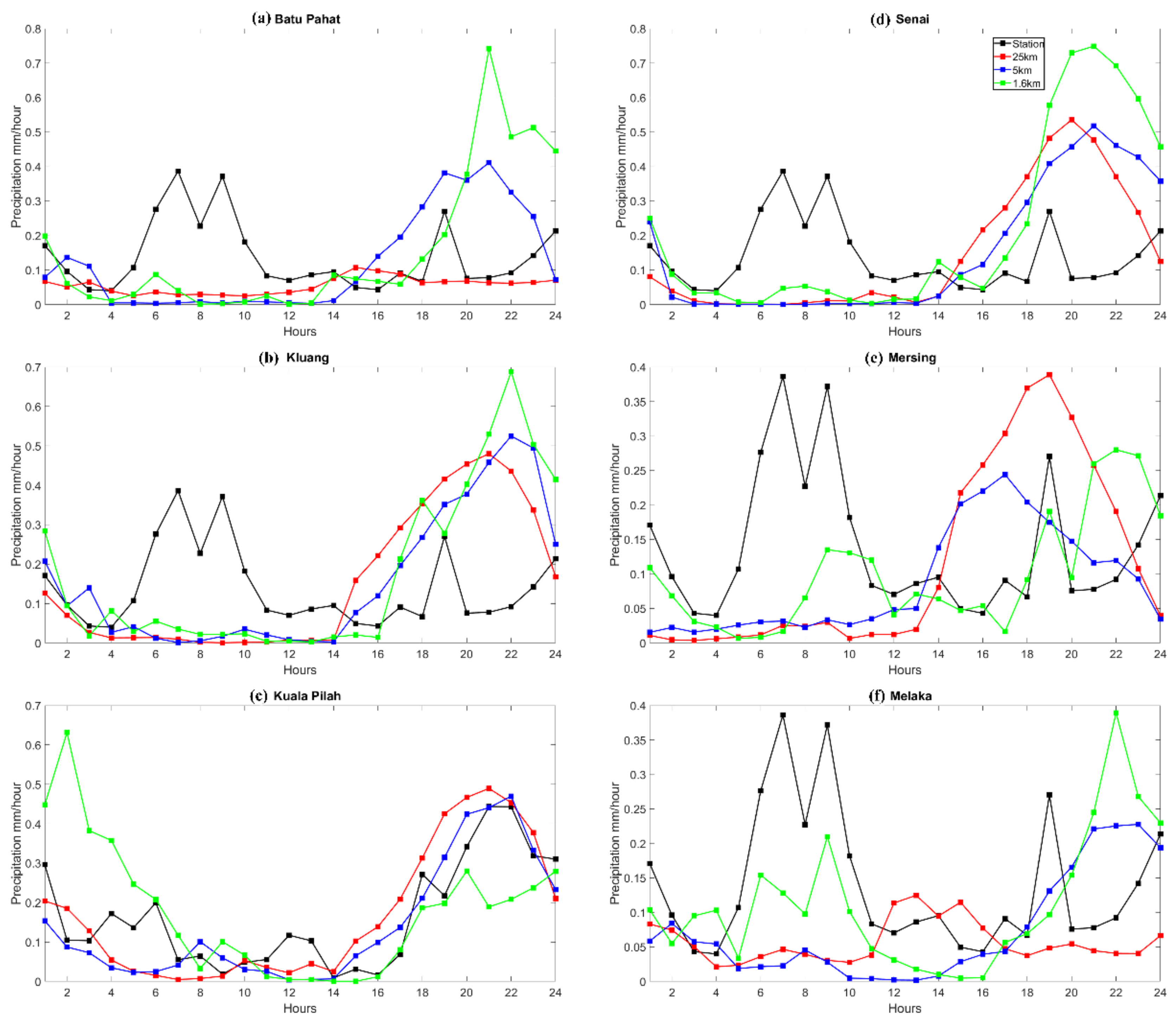
| Physics Scheme | Ratna Configuration | This Experiment’s Configuration |
|---|---|---|
| Microphysics Scheme | WSM 3-Class Simple Ice Scheme | WSM 3-Class Simple Ice Scheme |
| Land Surface Processes | Unified NOAH Scheme | Unified NOAH Scheme |
| Planetary Boundary Layer | Yonsei University Scheme | Yonsei University Scheme |
| Long Waves | Rapid Radiative Transfer Model (RRTM) | Rapid Radiative Transfer Model (RRTM) |
| Short Waves | Dudhia Scheme | Dudhia Scheme |
| Cumulus Parameterization | Betts–Miller–Janjic | Betts–Miller–Janjic Kain–Fritsch Grell–Devenyi Non-Cumulus Run |
Publisher’s Note: MDPI stays neutral with regard to jurisdictional claims in published maps and institutional affiliations. |
© 2022 by the authors. Licensee MDPI, Basel, Switzerland. This article is an open access article distributed under the terms and conditions of the Creative Commons Attribution (CC BY) license (https://creativecommons.org/licenses/by/4.0/).
Share and Cite
Amirudin, A.A.; Salimun, E.; Zuhairi, M.; Tangang, F.; Juneng, L.; Mohd, M.S.F.; Chung, J.X. The Importance of Cumulus Parameterization and Resolution in Simulating Rainfall over Peninsular Malaysia. Atmosphere 2022, 13, 1557. https://doi.org/10.3390/atmos13101557
Amirudin AA, Salimun E, Zuhairi M, Tangang F, Juneng L, Mohd MSF, Chung JX. The Importance of Cumulus Parameterization and Resolution in Simulating Rainfall over Peninsular Malaysia. Atmosphere. 2022; 13(10):1557. https://doi.org/10.3390/atmos13101557
Chicago/Turabian StyleAmirudin, Abdul Azim, Ester Salimun, Muhamad Zuhairi, Fredolin Tangang, Liew Juneng, Mohd Syazwan Faisal Mohd, and Jing Xiang Chung. 2022. "The Importance of Cumulus Parameterization and Resolution in Simulating Rainfall over Peninsular Malaysia" Atmosphere 13, no. 10: 1557. https://doi.org/10.3390/atmos13101557
APA StyleAmirudin, A. A., Salimun, E., Zuhairi, M., Tangang, F., Juneng, L., Mohd, M. S. F., & Chung, J. X. (2022). The Importance of Cumulus Parameterization and Resolution in Simulating Rainfall over Peninsular Malaysia. Atmosphere, 13(10), 1557. https://doi.org/10.3390/atmos13101557







